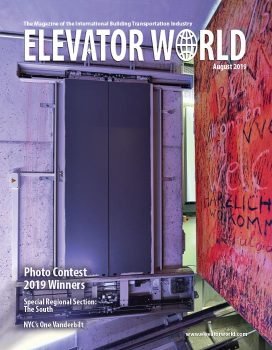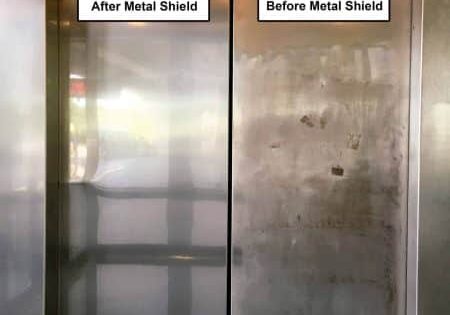Globalization in Standardization Moving Forward
Aug 1, 2019

The EN 81-20/-50 standards for lifts, produced by the European Committee for Standardization (CEN) international, has been accepted.
In Europe, the EN 81-20/-50 standards for lifts have been in place since August 31, 2017. The International Organization for Standardization (ISO) standardization committee TC 178 adopted these European CEN standards as ISO standards and published them on March 12, 2019, which means they are ready to be used.
The official names are ISO 8100-1:2019 (Lifts for the Transport of Persons and Goods — Part 1: Passenger and Goods Passenger Lifts) and ISO 8100-2:2019 (Lifts for the Transport of Persons and Goods — Part 2: Design Rules, Calculations, Examinations and Tests of Lift Components). ISO also published ISO 8100- 3:2019 (Requirements from other standards [ASME A17.1/CSA B44 and JIS A 4307-1/JIS A 4307-2] not included in ISO 8100-1 or ISO 8100-2) for America and Japan.
Specification
These standards specify the safety rules for permanently installed new passenger or goods passenger lifts, with traction, positive or hydraulic drive, serving defined landing levels, having a car designed for the transportation of persons or persons and goods, suspended by ropes, chains or jacks and moving between guide rails inclined not more than 15° to the vertical. In addition to these standards, supplementary requirements need to be considered in special cases (use of lifts by persons with disabilities, in case of fire, potentially explosive atmosphere, extreme climate conditions, seismic conditions, transporting dangerous goods, etc.).
Vienna Agreement
Pieter Schaareman, manager for Codes & Standards at Liftinstituut, is a member of the European standardization committee CEN TC 10 Working Group (WG) 1 and a member of ISO standardization committee TC 178 WGs 4 and 6. He explains:
“ISO’s adoption of these CEN standards is one of the results of the Vienna Agreement. The agreement on technical cooperation between ISO and CEN (Vienna Agreement) is an agreement on technical cooperation between ISO and CEN. Formally approved on June 27, 1991, in Vienna, this ISO standard is basically identical to EN 81-20, which is prepared by the European CEN TC 10 committee. And, the same applies to ISO 8100-2, which is similar to EN 81-50. Both ISO 8100-1/-2 and the European standards EN 81-20/-50 can be used by the industry, because the contents are the same. This also allows a smooth transition for the industry to globalize international standards.”
Future
Regarding the future of international standards, Schaareman stated:
“Standards, of course, are dynamic. Amendments and revisions are an ongoing process. The result of the revision currently prepared under CEN’s lead will be merged in a new version of ISO 8100-1 and -2. This revision of the standard is planned to be completed by June 2022. This is according to the current planning of the ISO development roadmap. The ISO standards will be adopted as EN-ISO 8100-1 and -2; EN 81-20/-50, as planned, will be withdrawn in this timeframe, so in the near future, only the ISO standards will be available providing requirements for lifts.”
Upcoming Revision in European and ISO Standards
When asked about the most important topics for the revision, Schaareman noted:
“The most important topics for the revision include, for example, rise and fall of vertical biparting doors; alternative means of suspension, such as belts or coated ropes, which are currently being used in lifts; the automatic rescue device, as an option, to move the lift to a specific floor to allow passengers to leave the car safely; an update of the requirements for programmable electronic safety systems (PESS) to the latest standards; requirements for freight lifts; well access in relation to refuge spaces; hydraulic brake release; and editorial corrections. . . . There also will be a review of well-access procedures.”
About CEN
CEN is an independent organization developing European standards. Members of CEN participate in standardization work and are obliged to adopt European standards as their identical national standards, regardless of whether they are members of the European Union (EU). Many countries outside Europe also use European standards as the basis of their national standards. The main reason for this is that the European standards for lifts and escalators are found to be well prepared, reasonable in their requirements and have a strong track record on safety. “As long as we provide high-quality and up-to-date standards, they will be appreciated and used worldwide,” said Schaareman.
Statement to Parties in European Standardization Activities
All stakeholders and interested parties are invited and welcome to participate in the standardization work. The European standardization system and process facilitates such participation. Participation may happen in different forms and through different forums. Any organization, based on its level of interest or available resources, may choose from several possibilities. For many members of the industry, whether it concerns small, medium-sized or large manufacturers, complying with the regulations is a matter of business survival. While not all companies have the resources or possibility to delegate a dedicated expert to these forums, they can give input via national trade organizations that represent the interests of all members of the industry at the national level. Many of the national trade associations are members of European federations that are in liaison with CEN or CEN Technical Committee 10. Therefore, they have direct access to standardization activities at the European level. Liftinstituut has been participating in standardization for more than 30 years.
Notified Bodies
Said Schaareman:
“Notified bodies play an important role within the European regulation for lifts. All conformity assessment procedures of the
Lifts Directive require involvement of a Notified Body (NB). In addition, certificates such as EU-type examination issued by an NB are also considered in conformity assessment procedures in many countries outside Europe. This is a big advantage for the European industry. Some NBs, such as Liftinstituut, are also very active with respect to standardization, at not only the national, but also at the European and global levels.”
Cybersecurity
Cybersecurity is not yet covered by any specific standard for lifts and escalators. However, the installer of a lift must consider all the hazards and risks applicable to the lift, taking into account any foreseeable misuse; e.g., depending on how the lift system is connected to the outside world and what may happen if the control
system is compromised. Regarding the general application of the standards:
“Risks covered by a particular standard are listed in section four of the standard, which could be consulted by installers to check whether a specific risk is addressed. Depending on the intended use and environment where the lift is installed, there might be some risks that are not covered by the standards for lifts. An example is a lift installed in an environment subject to explosion, such as a coal mine. In this case, the installer must address this risk using other standards or specifications and demonstrate that the chosen solution mitigates the risk adequately. In the end, the installer is responsible to address all applicable risks, and the standards may not cover all those risks.”
Get more of Elevator World. Sign up for our free e-newsletter.









